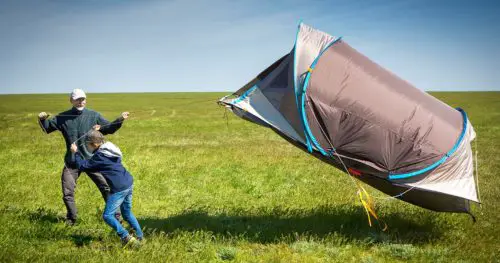If you want to go camping in all types of weather, our guide to the best tents for high winds can point you in the right direction.
Like the best tents for rain, tents for high winds will have certain features built-in, such as extra strong frames, to help protect you even in very stormy conditions.
We’re looking at 6 of the top tents today, but the question is – which one is the best?
The bottom line up front: we like the . It’s ideal for both windy and rainy weather.
We also like:
- – ideal for backpackers as it’s nice and lightweight
- – good for a bigger budget with luxurious extras
We’ll be looking at:
- What to look for in a tent for high winds
- 6 of the best out there, including pros and cons
- Some of the most frequently asked questions about tents for high winds
- Which one we like the best and why
Keep reading to find out more.
Table of Contents
- Best Tents for High Winds Compared
- What to Look for in a Tent for High Winds
- Top 6 Best Tents for High Winds
- Frequently Asked Questions
- To Sum Up – Which Tent for High Winds is the Best?
Best Tents for High Winds Compared




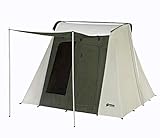






What to Look for in a Tent for High Winds
Here’s a rundown of the main features you should look out for when looking for a tent for high winds.
Weatherproofing
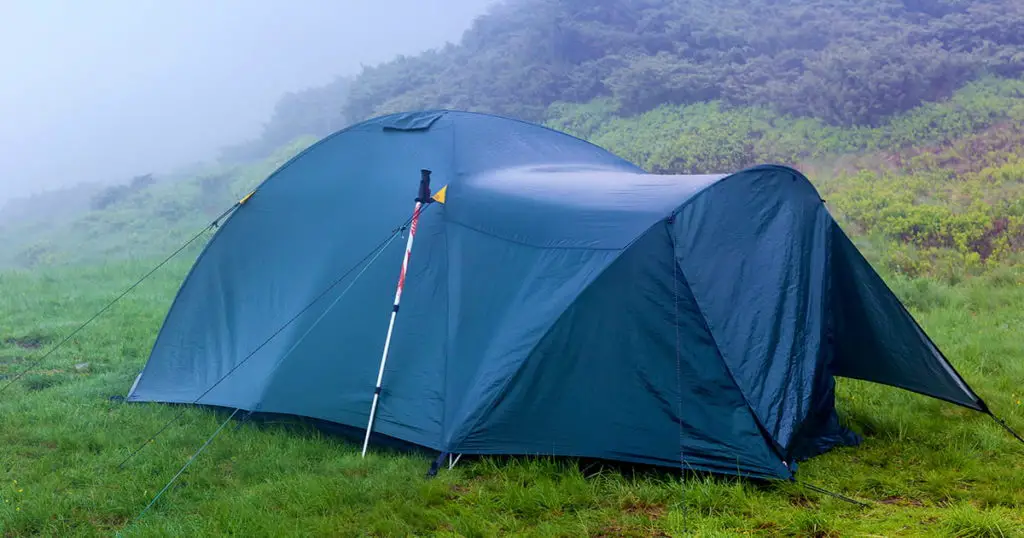
Starting with the obvious first choice, there are a few ways you can tell if your tent is going to be good for high winds (or bad weather in general – check out our guide for the best tents for bad weather for more recommendations).
Looking at the shape of the tent can give you a clue. As a general rule, a dome tent is better for high winds, because the closer the tent is to the ground, the less surface area the wind has to blow against.
However, don’t rule out cabin tents completely. Some are designed with extra strong frames to stay standing even when it’s windy.
You can also look for things like the strength of the pole clips (the parts of the frame that hold two poles together). If these are advertised as ‘extra strong’ or ‘reinforced’ you can bet that they’ve been designed to hold up well against the wind.
In terms of rain proofing, look for things like sealed seams (which help to prevent leaks from coming in at the side) and covered zippers (which prevent leaks from coming in via the zipper). It’s these small touches which will help you to stay dry even in a downpour.
You may see a measurement in millimeters when looking at outer tent wall materials. This refers to the hydrostatic head measurement, which measures the depth of the pool of water which can gather on top of a tent before it begins to seep through. A measurement of 1,500mm or above is pretty good in terms of keeping leaks at bay.
Tents tend to come with two features that are important for weatherproofing – a footprint and a rainfly. A rainfly is the name for the outer cover which protects the inner tent from getting wet. A footprint is a layer of waterproof material which separates your tent from the ground.
If your tent doesn’t come with a footprint, you can buy a generic one. We like the , which comes with its own drawstring bag for easy carrying.
Seasons
Here’s a quick guide on what is meant by a tent ‘season’:
- 1 Season – these are lightweight tents, with little-to-no waterproofing. Ideal for festivals in hot, sunny places.
- 2 Seasons – these offer a little more waterproofing, but still won’t hold up against prolonged rain.
- 3 Seasons – the most versatile option, these are good for stormy weather (by being both water and windproof) and hot weather (as they tend to have good ventilation).
- 4 and 5 Seasons – harder to find and quite expensive, these are designed for very extreme weather conditions (for example, camping in snow).
Generally, we’d recommend a 3-season tent for the average camper, as it covers all the bases in terms of weather protection. If you want to know more, check out our 3-season vs 4-season tent comparison.
Materials
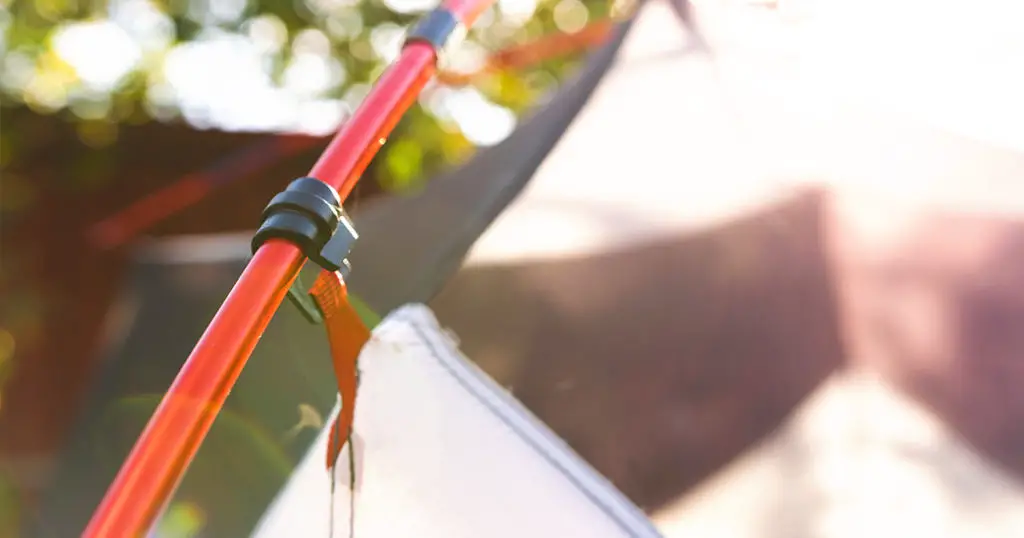
Poles are normally made from aluminum or fiberglass. Fiberglass is stronger and more durable, so it makes a better material for windy weather. It’s heavier than aluminum and more expensive.
When it comes to the material of the tent walls, they tend to be made from one of the following:
- PVC (Poly Vinyl Chloride) – commonly found in cheaper tents, this is not the most durable material out there. It’s not particularly breathable either, meaning it’s not ideal for hot weather.
- Polyester – this is a popular option for tents as it’s lightweight and durable.
- Nylon – this is very similar to polyester, but prone to UV damage, so it may not hold up over a long period if you often camp in sunny places.
- Polycotton Canvas – this a polyester/cotton mixture and is fairly durable and strong.
- Cotton – cotton tents are not that common to find. Made from pure cotton, they have to undergo a process of weathering (leaving them out in the rain) so that the fibers can swell and draw together, which prevents future leaks.
All of the above can be coated for extra weather protection. Coating is usually made from polyurethane or acrylic.
There are a few things you can do to weather a tent ready for your first trip. Camping World has a brief guide on what to do.
Size and Layout
Although a tent may say that it’s, for example, a 5-person tent, it may not comfortably fit 5 adults with all their gear. It’s worth looking at the actual floor dimensions so you can see where everyone will sleep. Some tents have separate bedrooms or detachable walls to create extra rooms.
Another thing to consider is headspace. If you want to be able to walk around in your tent, you’re better off going for a model with straight walls. If you’re a taller camper, it’s always worth checking the center height to see if you’ll fit comfortably (for more information on this, check out our guide to the best tall 4-person tents).
Finally, there’s storage to consider – where will you keep your gear? Smaller pockets sewn into the walls are ideal for water bottles, wallets, and phones, but for bulkier items like rain jackets or backpacks, you may need overhead gear storage or a covered vestibule to stash them away.
Ease of Setup
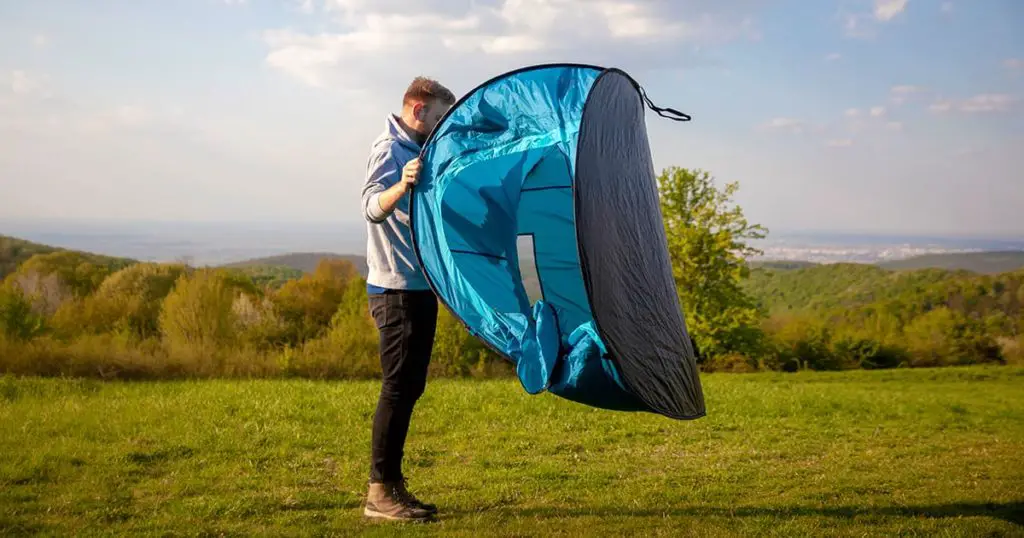
It’s always worth checking how easy it is to put up a tent before you buy it. If you’re new to camping, it’s tempting to go for something like a pop-up tent or an instant tent. However, it’s worth looking at the weatherproofing and durability, as pop-up tents tend to be constructed using an umbrella-like frame, which can sometimes bend out of shape during windy weather.
Some tents have small built-in features to make it easier, like pre-threaded poles, continuous pole sleeves (this means you don’t have to keep re-threading the poles through small gaps in the material), and color-coded poles.
Portability
Finally, there’s portability to consider.
The issue you may come across with tents for windy weather is that the poles, if you go for fiberglass, tend to be heavy.
This might be a problem if you’re backpacking, so you may have to mitigate the weight by cutting down on something else or splitting the tent between you and another person. Eagle Creek has a great guide on what to pack for travelling, which may help you figure out how to save space.
Check out our guide to the best backpacking tents for under $100 for some recommendations for lightweight backpacking tents.
Looking at the size packed will tell you how small the tent is once it’s folded into its carry bag (not all tents have carry bags however – it’s worth checking this before you buy). This will enable you to see whether or not it will realistically work for you, especially if you’re planning on taking it on a plane or squeezing it into a backpack.
Top 6 Best Tents for High Winds
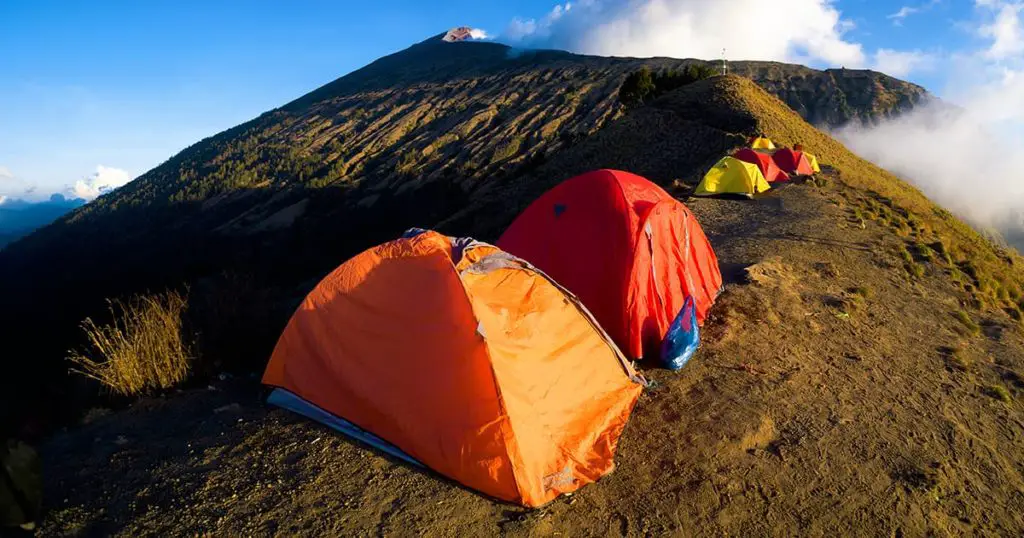
Now let’s take a look at 6 of the best tents for bad weather in more detail.
North Face Stormbreak 3 – Best for Backpackers
Key Features
- Sleeps: 3
- Size:
7ft 3 in x 5ft 4in x 3ft 8in (ft)
88 x 65 x 46 (in)
224 x 165 x 117 (cm) - Size packed:
8 x 22 (in)
20 x 55 (cm) - Carry bag included: Yes
- Weight: 2.76kg / 6.10lb
- Materials: Coated polyester
- Seasons: 3
The is a good tent for backpackers, and the dome shape improves wind-resistance as there is a smaller surface area for the wind to blow against. It has two full-length poles and 2 shorter poles in the ceiling, to stop the tent from caving in at the top during windy and rainy weather. It has coated polyester walls and is great for keeping the rain out. You do have to buy a footprint separately though – we like the REDCAMP Waterproof Camping Tarp, as it’s durable and compact when folded down.
It’s a smaller tent, which makes it good for backpackers, but not so good if you want a lot of space to lounge around. It has small pockets for valuables, but no overhead storage.
It’s easy to put together and can be done in around 5 minutes. Plus, it packs up into a very small bag and is lightweight to carry.
Pros
- Frame is designed to stop the top from caving in
- Good waterproofing
- Small and lightweight to carry
Cons
- Footprint has to be bought separately
- No overhead storage
Coleman WeatherMaster 10-Person Tent – Best for Larger Groups

Key Features
- Sleeps: 10
- Size:
17 x 9 x 6ft 8in (ft)
204 x 108 x 82 (in)
519 x 275 x 207 (cm) - Size packed:
30 x 10 x 10 (in)
76 x 25 x 25 (cm) - Carry bag included: Yes
- Weight: 31lbs / 14kgs
- Materials: PU-coated polyester
- Seasons: 3
The is a great tent for weatherproofing all-round. In terms of wind, it has a strong frame made from fiberglass poles – it can cope with some pretty stormy weather and still stay put. It also has fully taped seams and covered zippers, to prevent leaks in heavy rain.
The tent sleeps 10, but would be ideal for around 6-8 people, as that will give you plenty of floor space. It has enough room for three queen-sized air beds and storage pockets, but it does lack overhead storage, which means you’ll have to leave your larger items (like backpacks) on the floor.
It’s also fairly easy to assemble. The color-coded poles and continuous pole sleeves help, as it means you won’t have to keep re-threading the poles through small gaps. The instructions are sewn into the case, which is a helpful touch – and it folds up pretty small.
Pros
- Great weatherproofing all round
- Lots of floor space
- Easy to assemble
Cons
- Lacks overhead storage
Coleman Elite Montana 8-Person Tent – Best for a Bigger Budget
Key Features
- Sleeps: 8
- Size:
16 x 7 x 6ft 2in (ft)
192 x 84 x 74 (in)
488 x 213 x 188 (cm) - Size packed:
33 x 13 (in)
84 x 33 (cm) - Carry bag included: Yes
- Weight: 12.42kg / 27.4lbs
- Materials: Coated polyester
- Seasons: 3
The is ideal if you have a bit more money to spend. Despite being such a large structure, it’s very sturdy, with extra-strong guy lines to ensure the tent stays attached to the ground even in very windy weather. The poles are designed with Coleman’s Insta-Clip technology, meaning the clips that hold the poles together won’t come undone in strong wind. It’s also great for waterproofing, with sealed seams and coated polyester walls to keep out leaks. It has auto-roll windows which automatically roll down when you unzip the tent, and you can even open them at an angle to keep you dry whilst still allowing in some light when it rains.
The tent has a lot of extra touches which make it a great luxury choice. It has built-in LED lights, that can be powered by batteries or by using the rechargeable power cartridge which comes with the tent. It has an energy pack that can charge anything with a USB slot. It’s also roomy, with three queen-sized air beds and an extended door awning for storing gear. It has small storage pockets, but no overhead storage.
It’s a large tent, so it takes a little while to put together – it may be worth practicing before you leave for your first trip. It can take around 20 minutes to do once you get the hang of it (this video shows a timed set up for this tent – it takes them 28 minutes on the first attempt). It’s a heavy tent too, and although it folds up compactly into the storage bag included, it’s not ideal for carrying around for too long due to the weight.
Pros
- Extra-strong guy lines and pole clips are good for windy conditions
- Great weatherproofing
- Auto-roll windows and built-in LED lights are nice extras
- Fairly simple to put together
Cons
- Takes a while to put together
- Heavy to carry
Browning Big Horn – Most Versatile

Key Features
- Sleeps: 8
- Size:
10 x 15 x 7ft 2in (ft)
120 x 180 x 87 (in)
305 x 457 x 221 (cm) - Size packed:
12 x 30 (in)
30.5 x 76 (cm) - Carry bag included: Yes
- Weight: 35lbs / 16kgs
- Materials: Polyester
- Seasons: 3
The is another one that can face up to the elements – it has fiberglass poles and steel uprights, and it’s designed to be free standing (it does come with stakes and guy lines, which will allow you to attach it to the ground for extra stability). It has 2,000mm coated polyester floors, factory-sealed seams and a mesh roof for ventilation, so it can work well in all types of weather.
It’s a spacious tent, with a detachable room divider. You’ll have enough room for two queen-sized airbeds, and small storage pockets for valuables. The only thing it lacks is overhead storage, which means you’ll have to find somewhere to put your gear.
It’s pretty simple to put together, and it takes two people 15 minutes or less to assemble. It packs down into a fairly small storage bag.
Pros
- Very strong frame
- Waterproof
- Versatile room layout
- Simple to put together
Cons
- Lacks overhead storage
Kodiak Canvas Flex-Bow Tent – Best for Rain Resistance

Key Features
- Sleeps: 6
- Size:
10 x 10 x 6ft 6in (ft)
120 x 120 x 79 (in)
305 x 305 x 202 (cm) - Size packed:
30 x 16 x 5.5 (in)
76 x 40.5 x 13.97 (cm) - Carry bag included: Yes
- Weight: 30.84kg / 68lbs
- Materials: Coated cotton canvas
- Seasons: 4
The is a great choice if you want to stay dry in a downpour. The coated canvas outer walls stop rain from entering, even in harsh storms. The frame is also strong and designed to withstand windy conditions. It’s also good in warm weather, as it has mesh panels to improve ventilation.
It’s fairly roomy with an overhead storage loft, which is ideal for stashing your gear up and away. It has large doors at the front and back, and smaller pockets for valuables. It has a built-in awning, which is ideal for either keeping extra gear, or sitting outside whilst staying under cover.
It’s pretty easy to put together – it has simple instructions which are easy to follow. However, it fits into two separate bags rather than one – the poles are kept in one bag, while the tent fabric itself is kept in another (the bags are included). It’s worth noting that the poles are very heavy, so it’s not the best tent for backpackers.The poles have their own bag as they’re very heavy, so it’s not the best tent for backpackers.
Pros
- Strong, heavy frame keeps it upright in a storm
- Great waterproofing
- Simple to set up
- Good storage
Cons
- Heavy to carry
NKT Super Arizona GT – Good for Storage
Key Features
- Sleeps: 11-12
- Size:
6ft 9in x 10ft 2in x 20ft 6in (ft)
83 x 122 x 247 (in)
210 x 311 x 627 (cm) - Size packed:
24 x 18 (in)
61 x 46 (cm) - Carry bag included: Yes
- Weight: 6.5kg / 18.74lb
- Materials: Coated polyester
- Seasons: 3
The has fiber-glass poles that are designed to withstand windy weather, and they’re powder-coated to prevent corrosion. It’s also good at keeping the rain out, with 2,500mm coated polyester outer walls, and heat-sealed seams. It also has UV protection and mesh windows for ventilation.
The tent has a lot of floor space, with a detachable room divider to create two bedrooms (or one bedroom and a living area) if you need to. It has large storage pockets and a gear loft for bigger items, so it will still feel roomy even after you’ve unpacked. The tent also has extra poles to create an extended canopy, if you want to sit outdoors and still have a bit of shelter.
Although assembly isn’t difficult, it is time-consuming given the size of the tent. It’s also on the larger size when packed for this reason and feels quite hefty to carry around.
Pros
- Durable powder-coated frame
- Good weather protection
- Detachable inner wall
- Lots of storage
Cons
- Takes a while to put together
- Large and heavy to carry
Frequently Asked Questions
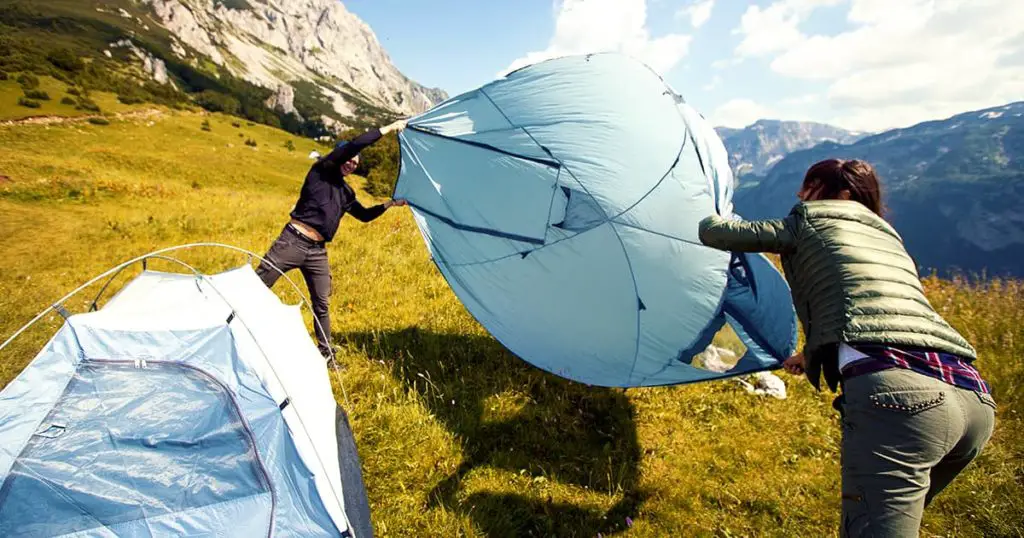
Here are some of the most commonly asked questions about tents for high winds:
How much wind can a tent take?
The average tent can take around 30mph / 48kmph of wind. This does vary depending on the tent itself.
Canopy tents can take between 18-30mph (29-48kmph). You can see more detail on this in our guide: How Much Wind Can a Canopy Tent Take?
How can I make my tent more waterproof?
If you’ve chosen a wind-proof tent but want to make it more waterproof too, you can use a waterproofing spray, like the .
Will my tent come with a warranty?
It depends on the individual tent, but most tend to come with a 1-year warranty on defects. This gives you time to test out the tent a couple of times to make sure it was manufactured correctly.
Can I buy a tent second hand?
Yes, you can – but it’s worth going to see it in person and thoroughly checking it for rips, tears, or corrosion in the frame.
To Sum Up – Which Tent for High Winds is the Best?
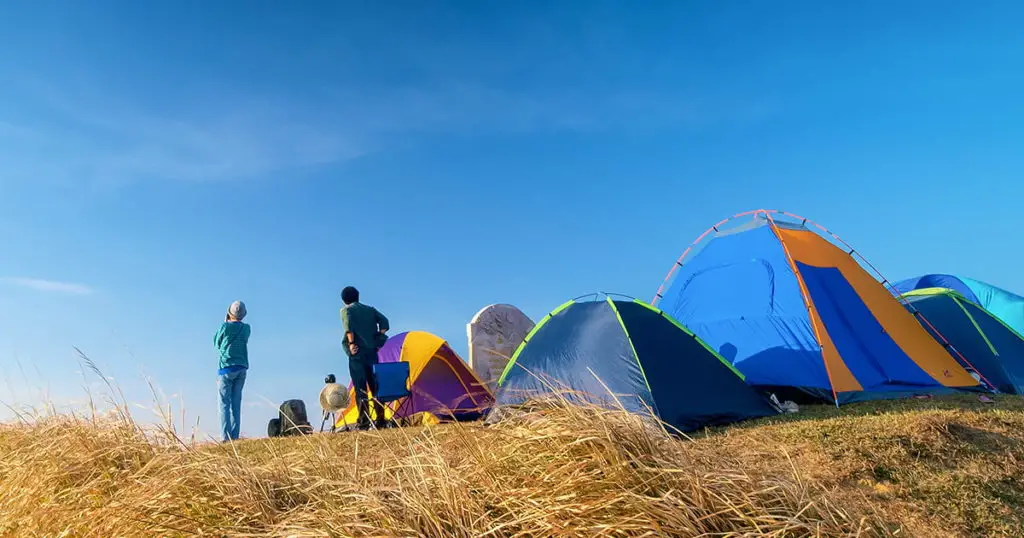
We really like the . It’s a great all-rounder for bad weather, as it will keep you safe and dry even in a storm. We like that it’s easy to put together, too.
However, it’s worth looking at the if you’re backpacking. Despite being lightweight, it’s still good for windy weather.
If you want a tent with extra features, try the . It’s a spacious, useful tent with some great tools for modern camping.
We hope this has helped you find the best tent for high winds!
